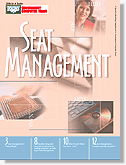 |
 |
||
|
Are You Ready For Seat? March
29, 2000
Seat
Management Is Federal-Ready
Seat
Management is not only expanding in government but is maturing too.
This was the message at a conference in Washington, where new and
evolving projects in a variety of federal agencies were examined for
"lessons learned." Generally, Seat is perceived as a challenge to traditional IT procurement. Its advocates believe that agencies need to get out of the business of specifying technology--a process that might begin with selecting desktop hardware and application software but will likely demand expertise in servers, databases, operating systems, network management, Help desk, training, software distribution, security, IT asset management, and so on. Instead of requiring that industry meet variant technical standards for each of these different disciplines, Self and others who spoke at the recent "Are You Ready for Seat Management?" conference believe agencies should express requirements focused only on the government's core business concerns. Contractors can then meet the overall IT support need with technology best suited to the level of service required. "Seat Management is really a way of shifting the accountability for the unified delivery of desktop and network services to us," said Teresa Weipert, a Unisys vice president and general manager. Unisys provides Seat services to the Bureau of Alcohol, Tobacco and Firearms (ATF). What Weipert called a "commodity service that's more than just people and products," Patrick Schambach, the ATF CIO, called a "full partnership with our contractor." Among the many "lessons learned" discussed at the conference, Weipert stressed that Seat gives each side of the contracting paradigm a reason to "communicate both the good and the bad to each other, and not hide problems." An effective Seat Management contract is in a constant state of review, Schambach said. Speaks
a Zealot Lt. Col Alvin Lee, a technology branch chief and program manager at the Air Education Training Command, riveted the conference's attention on a TCO study he led at Randolph Air Force Base. Officials found that "soft costs" per client in a desktop environment can spiral as high as $12,000 per year--a situation that is exacerbated by inadequate and/or duplicate hardware, poor or non-existent IT support and help desk, inadequate training, weak network management, persistent security problems, and so on, Lee reported. A Gulf War veteran and self-described "Seat Management zealot," Lee believes the case for rectifying these costs with Seat is compelling. "We're the Air Force," he said. "Our primary job is to put holes in the other guy faster than he can put holes in us. Anything that detracts from our core mission is stupid and wasteful." Lee envisions an effort to implement Seat for 60,000 AETC users at 53 bases. Any such effort would no doubt gain insight from that of the Housing and Urban Development Department, Office of the Inspector General. This 62-location Seat implementation is beginning now with a pilot rollout in New York, said Fred Gantzler, senior vice president at DynCorp, the OIG contractor. Getting
Exec Buy-In The system also might typify Seat's grind through cultural blocks as it has arrived in government. The HUD OIG project snagged as designers sought to plan necessary interfaces to other areas of HUD, where older contracts remain in place. Gantzler said the participation of the Inspector General and the Deputy Inspector General of HUD was essential in smoothing out such problems. "It's very important to have buy-in and support from the executive level in an agency," he said. "If you don't have it, things can get out of control." He conversely advised agency senior staff not to micro-manage a Seat project--which would effectively negate the central idea of turning all the technical headaches over to a contractor. Life
In a "Steady State" The ODIN contractor at Goddard, Intellisource Information Systems, provides a full menu of desktop support services (help desk, tech refresh, data backup, maintenance) and full network seat services such as directory, PKI, e-mail, network management and news server, Silverstein said. The Goddard ODIN services model leads to "a steady state of operations in a stable seat services environment," he said. Mars Mariano, the Intellisource Goddard project manager, reported that Intellisource and NASA measure "support delivery" against the SLAs on a monthly basis. He gave the conference a brief glimpse of the factors that have led to monthly success rates ranging from 90 to 99 percent, and noted that areas of improvement for service delivery and availability, and customer satisfaction, are often identified as service is measured. A number of speakers described Seat as providing IT to agencies the way a "dial tone" is presented to phone customers. Essentially, the tone represents the entirety of the communications infrastructure supporting it, which a user never has to think about when making a call. Soften
Your Soft Costs While conceding that Seat might have gotten off to a rocky start, Self and others pointed out that if the Fortune 500 won't be able to hire enough expertise to run their own IT shops then government will have no choice but to outsource its desktop support and service needs. But even if this were not the case, advocates point to TCO studies that show how soaring soft costs can only be corrected with better hardware and support. Soft costs of $10,000 and more are emerging in many agency studies, which look especially harsh alongside ATF's recent finding of less than $5,000 with Seat in place. ATF's trade-off was a modest expenditure for new hardware that brought 5,000 users at 188 locations a standardized workstation and remote computing platform, coherent e-mail, Internet access, faster processors, new LANs, user and administrator training, and online help. Soft costs are the costs agencies incur as a result of IT use, though they usually show up in operational and efficiency losses, not in IT budgets. Seat is sometimes hard to "sell" to agency higher-ups because lowering these soft costs will require an increase in overall IT expenditure. But GSA, the Air Force and other agencies who have rolled up their sleeves and closely examined TCO have uncovered staggering productivity losses in current environments. Lt. Col. Hill found that the average desktop user at AETC spends 9.3 hours per month fixing his or her own IT problems and spends another 9.2 hours per month helping coworkers with their IT problems. The productivity loss is 15 percent or three days per month lost for each employee. "At one of our bases that's the equivalent of 480 people not at work," Hill said. Pitted directly against these kinds of problems, the case for Seat Management begins to make itself. The conference was presented by the Council for Excellence in Government, the Digital Government Institute, the GSA's Federal Technology Service and GCN. It was sponsored by NCI Information Systems Inc., Unisys, DynCorp, and Intellisource. |


